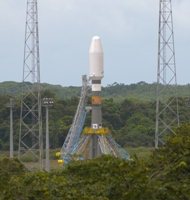European firsts for Galileo satnav and Soyuz
03 October 2011
The countdown is under way for two landmark events in the history of European space. If all goes according to plan, the first Soyuz rocket to fly from the Kourou Spaceport in French Guiana will lift off on 20 October. The Soyuz ST-B vehicle will be carrying the first two satellites in Europe’s Galileo satnav system.
The Russian-built Soyuz is one of the most reliable launchers in the world. With the completion of a new launch site at Kourou, the three-stage rocket will be able to carry heavier payloads into orbit.
The first test satellite in Europe's Galileo navigation system was launched in December 2005, followed by a second one in 2008. The success of these pathfinders cleared the way for the upcoming launch of the first two Galileo In-Orbit Validation (IOV) satellites. Next year, they will be joined by a second pair of satellites.
The four IOV spacecraft, each weighing about 730 kg, are built by an industrial team led by EADS Astrium of Germany. They will be used to prove the design of the Galileo system, in advance of the other 26 satellites that will eventually join them. One of the items to be tested is the best atomic clock ever flown for navigation – accurate to one second in three million years. The satellites also carry a powerful transmitter to broadcast precise navigation data worldwide.
When the constellation is completed, the system will consist of 30 satellites circling over 23,000 km above the Earth. There will always be at least four satellites above the horizon, wherever you are in the world. This will ensure that Galileo is available 24/7 to help people on the move to find their way.






